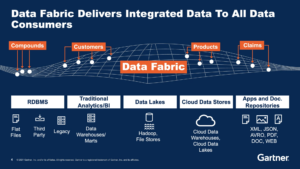
Breaking Down Silos, Building Up Insights: Implementing a Data Fabric

(amiak/Shutterstock)
Data is the lifeblood of modern business, but for commercial-sized companies, managing and leveraging data can feel like navigating a maze. But what if there was a way to simplify the journey and unlock the full potential of a company’s data? Read on to learn how a data fabric can add value by maximizing the value of a company’s data infrastructure.
Large, global enterprises have massive data teams set up to transfer and manage their data, using approaches like a data mesh. But commercial-sized companies are also dealing with more and more complex data landscapes, and finding that a disconnected, siloed data strategy can hold them back from operating at peak potential. For these companies, a more centralized data fabric approach can make the most sense.
What is a Data Fabric?
A data fabric describes a centralized approach to data management, designed to streamline data access and control. Gartner uses the term data fabric to help describe how different data sources can integrate and support each other to drive better decisions. Unlike a decentralized, domain-driven data mesh, which focuses on distributed ownership and governance, a data fabric offers a more traditional architecture that simplifies data management without the complexity of a decentralized system.
The Advantages of a Data Fabric
The adoption of a data fabric architecture offers commercial companies a slew of advantages, including:
- Data alignment and clarity: By consolidating data into a central repository, a data fabric enables employees across various departments to access and analyze data seamlessly, while ensuring everyone is working from the same information. Instead of each department drawing conclusions from their own datasets, each dataset is combined so that every department is making conclusions from the same source of truth.
- Agility in decision-making: With a data fabric’s centralized control, companies can quickly access and analyze relevant information. Leveraging analytics and machine learning on a unified data platform can further enhance business intelligence. This centralized approach provides a competitive edge, allowing agile businesses to outmaneuver larger, more cumbersome organizations.
- Enhanced security and compliance: A data fabric simplifies the management and enforcement of security protocols and compliance requirements by providing a centralized platform for data governance. When data is fully centralized and managed by a core data team, compliance and security are managed in tandem with secure integrations, user control and detailed logging.
- Real-world application: For an e-commerce start-up or similar company, a data fabric strategy consolidates customer data from various sources, including an e-commerce platform, marketing automation tools and customer support systems. This unified view enables them to analyze customer behavior, identify pain points and optimize their marketing and sales strategies accordingly, ultimately driving growth and improving customer satisfaction.
Uncover Deeper Insights
After deploying a data fabric and integrating different data sources, a company will have a much more comprehensive view of their customers that can drive loyalty, while also gaining a better picture of the actual ROI of a particular customer engagement by facilitating metric that span different parts of an organization.
For example, if a company closes a large deal with a new customer, evaluating profitability would usually look at the cost of materials, staffing, marketing, operations and sales commissions. But if a customer requires multiple support calls and post-sale handholding, profits quickly disappear. Unfortunately, if a company doesn’t have insight into their per customer support costs, a customer that requires $50,000 in customer success costs could turn a profitable deal into negative ROI, if post-sale expenses weren’t factored into the deal.
Overcoming Challenges
While a data fabric can offer significant benefits, companies can also face implementation challenges and integration complexities.
Data silos can hinder the successful adoption of a centralized data management approach. One of the top challenges for implementing a data fabric in the commercial space can be the unwillingness or inability to easily share data between groups and functions.
If a company’s sales data in Salesforce is isolated from its customer support data in Zendesk, it makes it harder to uncover the challenges a customer is facing when a contract comes up for renewal – similar to the problem above where disconnected data can’t tell a complete story. But if the salesperson can see that a customer called asking for a new capability, what could have been a profit-draining support call can actually turn into a sales opportunity to add new products or services down the road.
Implementing a Data Fabric: A Step-by-Step Guide
- Select the right technology: The first step in implementing a successful data fabric strategy is to choose a user-friendly data integration platform with connectors for all necessary services. This platform should simplify the process of extracting, loading, and transforming data from various sources, ensuring a seamless integration of data into the centralized repository.
- Foster a cultural shift: Implementing a data fabric requires more than just technological solutions; it also demands a cultural shift within the organization. Commercial companies must actively encourage a mindset shift towards data sharing and collaboration, emphasizing the benefits of a unified approach to data management.
- Establish governance and a Data Center of Excellence (DCoE): To ensure the success of a data fabric implementation, companies should establish a Data Center of Excellence function responsible for overseeing data governance, standardization and best practices. This team can develop and enforce consistent data definitions, calculations, and metrics across the organization, ensuring the integrity and reliability of the centralized data repository.
Embracing the Future of Data Management
For commercial companies seeking to unlock the full potential of their data assets, drive operational efficiency and make informed decisions, a data fabric can improve the intelligence that a modern data stack provides, while setting the framework for future growth.
By centralizing data management, companies can simplify data access, enhance security and respond rapidly to market changes, positioning themselves for success in an increasingly competitive business landscape. Organizations will need to break down silos to ensure data consumers have the access they need to do their work, but the benefits far outweigh the challenges of adopting modern data integration technologies with valuable insights, informed decisions, and data-driven innovation across the entire company.
Data Mesh Vs. Data Fabric: Understanding the Differences
Data Fabrics Emerge to Soothe Cloud Data Management Nightmares





























